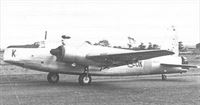Фотографии
-
Spitfire 2002 ‘11’ with a damaged propeller after Israeli Tibi Ben-Shachar damaged the wing of Yeshayahu Shaya Gazit in a mid-air collision on April 6, 1949. Both Ben-Shachar and Gazit graduated their flying course on March 14, 1949 together with Daniel ‘Dani’ Shapira and Mordechai ‘Mod’ Hod. Following the receipt of their wings, the four pilots attended an OTU with 101 Squadron and on April 6,1949 ‘Syd’ Antin led them into a cloud during a rain storm causing Ben Shachar’s propeller to collide with the underside of Gazit’s port wing. Both pilots landed safely and made distinguished careers in the IDF/AF but Spitfire 2002 was probably withdrawn from use in 1950.
Самолёты на фотографии: Supermarine Spitfire Mk.IX / XVI - Великобритания - 1942
-
The end of the first Israeli Spitfire. The remains of Spitfire 2001 ‘10’ after it burnt-out at its pen at Ramat-David in August 1951. (Dan Barak collection via Shlomo Aloni)
Самолёты на фотографии: Supermarine Spitfire Mk.IX / XVI - Великобритания - 1942
-
Регистрационный номер: D-ACON Condor D-ACON at Floyd Bennett Field, 1938.
Самолёты на фотографии: Focke-Wulf FW.200 Condor - Германия - 1937
-
Photographed recently at the excellent Avro Heritage Centre at Woodford, near Manchester was this array of models - just a small part of the large collection on view. In the foreground is what the Editor believes to be the Avro 779 high wing freighter version of the Avro/HS.748. Was this a possible contender for the requirement that was eventually met by the Avro 780 Andover? That being the case, its similarity to the Handley Page HP.124 - aimed at the same RAF requirement - is striking. Behind the Avro 779 come: the HS.860 a twin jet airliner clearly owing much to the 748; a standard model of the Avro 748; what is thought to be the Avro 775 twin-Tyne plus RB.168 booster Shackleton replacement; a Queen’s Flight Andover CC.2; and what is thought to be the Avro 781 twin turbofan ‘shortened’ 748 with engines mounted in the fashion of the VFW 614. More details on these projects would be appreciated.
Самолёты на фотографии: Hawker-Siddeley Andover / HS.748 - Великобритания - 1960
-
Регистрационный номер: PH-SAE Interior of DC-7 PH-SAE, 1969.
Самолёты на фотографии: Douglas DC-7 - США - 1953
-
Replica of the IAR-80 No.1 now on show at Bucharest’s aviation museum.
Самолёты на фотографии: IAR IAR-80/81 - Румыния - 1939
-
Самолёты на фотографии: IAR IAR-80/81 - Румыния - 1939
-
Регистрационный номер: RP402 The November/December 1996 issue dealt briefly with the Wellington T.10 ‘stop-gap’ navigation trainer. The type served widely with 2 Air Navigation School using large numbers at Middleton St George and, from 1950, at Thorney Island. RP402 ‘FFOV’ shows the initial Bomber Command camouflage, but with yellow ‘Trainer Bands’ on the wings and mid-fuselage. Note that the Flying Training Command four-letter code is also against a yellow background.
Самолёты на фотографии: Vickers Wellington / Type 271 - Великобритания - 1936
-
Регистрационный номер: NA971 NA971 ‘FFOO’ illustrates the definitive silver/yellow scheme. It did not last long after the move to Thorney Island, being struck off charge in October 1951.
Самолёты на фотографии: Vickers Wellington / Type 271 - Великобритания - 1936
-
Регистрационный номер: NA853 NA853 ‘FFOK’ exhibits what are thought to be black spinners - or was there colour-coding for the three flights of 2 ANS?
Самолёты на фотографии: Vickers Wellington / Type 271 - Великобритания - 1936
-
In early November ‘AE’ contributor and stalwart Paddy Porter died at his home in Boston, Lincs. Paddy contributed several features to ‘AE’ and countless photographs and comments. We miss him greatly. As a tribute to a rare kind herewith a photograph from his archives showing not just four Vickers Virginias in the air in ‘loose’ formation - as shown in the January-February 1997 issue on page 18 within ‘Enduring Nocturnal’ - but five in what is perhaps best described as a ‘generous vic’. They were performing at the Hendon Air Pageant of 1928 and were on their way up to execute an ‘air raid’.
Самолёты на фотографии: Vickers Virginia - Великобритания - 1922
Статьи
- Round-Out
- A.Pelletier - Paper Darts to Deltas
- A.Thomas - More from Mesopotamia
- A.Walg - Wings over the Steppes (3)
- B.Elliott - Bears in the Air
- B.Marshall - The 'Flea' and Me
- B.van der Klaauw - Fokker's American Heydays
- B.Walters - Nearly, but not Quite
- D.Henley - Singular Customer
- K.Wixey - Corpulent Feline (1)
- K.Wixey - 'Wild Catfish'
- M.Davey - Pacific Naval War
- M.Lopes - In at the Deep End










